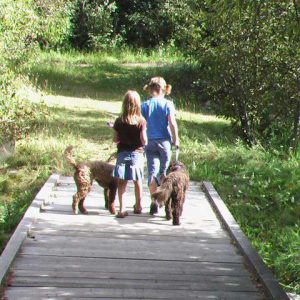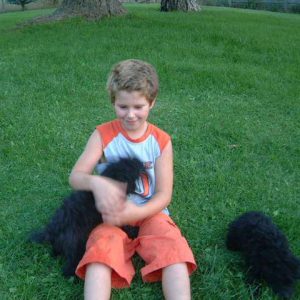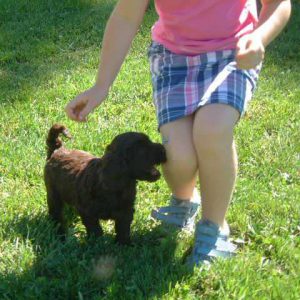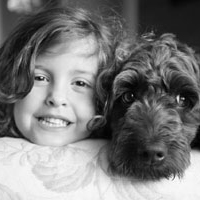Kids and Labradoodles
“Where best friends are born”
“Can we get a puppy!”
Dogs + Kids = Warm, loving companionship — or chaos?
Well, that’s up to you. The benefits of canine friendship can be many.
Kids can learn that responsible care-giving is well worth the effort for the love and companionship they receive in return. They can also learn a sense of trust and security that will carry over into their human relationships. There is, however, a lot you need to know to ensure that your child has the same fond memories of growing up with Rover as you did.


Building any good relationship takes understanding, communication and realistic expectations. The relationship between a child and a dog can be very special, but it needs guidance to become a rewarding experience with lasting good memories. So teach your child how to get along with dogs and reap the rewards of all those warm wet kisses and big hugs. Below are some thoughts on how to keep everyone in your family safe and happy.
“Every child should grow up with a dog. I did.”
Does your child want a dog? Ask him or her. Maybe it’s not the right age or time, or the child isn’t ready for the responsibilities of caring for a dog. Maybe your child is too busy with other activities. Maybe you’re the one who really wants the dog. Regardless, you as the adult, are the individual ultimately responsible for the dog’s health and welfare.


“Billy, this is Rover. Rover, Billy.” Now what?
What do these two wily creatures need to know about each other? Not a lot. They both need to learn how to behave and communicate with each other. The first message: Be Gentle and Learn Mutual Respect.
Other tips:
- Do explain to your child that since dogs can’t talk like we do, they communicate in different ways, such as facial expressions, body posture, or barking. Your child should learn to be sensitive to the dog’s behavior
- Do demonstrate how to interact with the dog. Show the child how to pet the dog nicely, to give the dog some space if it gets anxious, and how not to pull the dog’s tail, or ears, or poke its eye. Carefully explain that a dog is not a toy.
- Do make sure your dog has basic obedience training. The dog needs to know what is expected of it, and you need to establish a form of communication with your pet. Consulting a qualified obedience instructor can be helpful.
- Do be consistent in all teaching endeavors.
- Do supervise all puppy – child interactions. The adult in the household is the responsible party to be sure interactions are fun and mutually respected.
- Do oversee the dog’s care and well-being at all times.
- Don’t expect any dog to tolerate ear tugging, tail pulling or the like. Intervene if play gets rough or out of hand.
- Don’t force responsibility on the child that he or she is not ready for. The dog will suffer the consequences of being neglected, ignored and not properly cared for.
– Article from The American Kennel Club.


